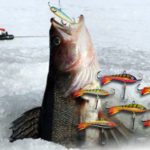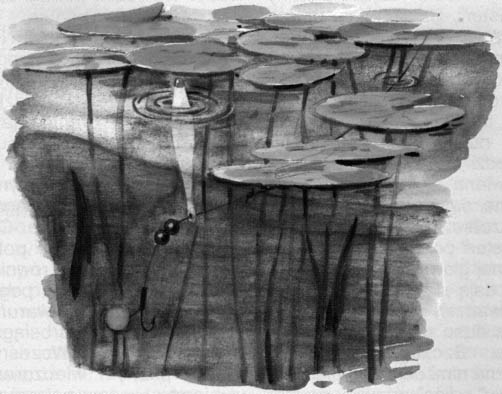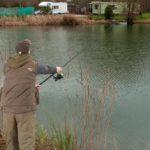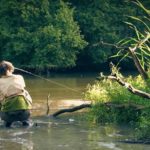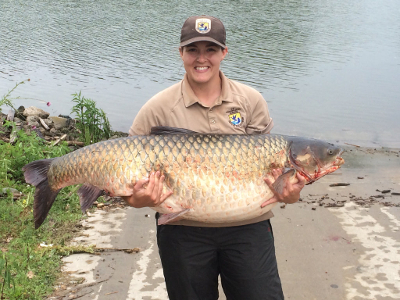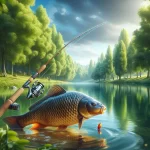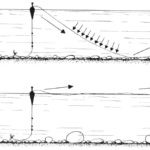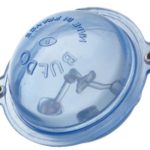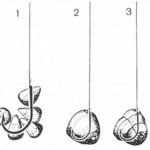Jakimi metodami łowić karpia.
 Podejrzliwego karpia można zwieść np. przez zastosowanie przyponiku z cienkiej żyłki. Przynętę należy dowiązać do pustego haczyka jak najcieńszą żyłką; przy jej przełykaniu karp wciągnie do pyska także pusty haczyk
Podejrzliwego karpia można zwieść np. przez zastosowanie przyponiku z cienkiej żyłki. Przynętę należy dowiązać do pustego haczyka jak najcieńszą żyłką; przy jej przełykaniu karp wciągnie do pyska także pusty haczyk
Z analizy skuteczności poszczególnych przynęt w połowach wynika, że łowiąc karpia można brać pod uwagę następujące metody:
– połów gruntowy;
– połów w toni wodnej;
– połów na powierzchni.
Podstawową metodą jest połów gruntowy. Jego istota polega na tym, że przynętę umieszcza się na dnie za pomocą obciążenia lub tylko wykorzystując jej własny ciężar (możemy stosować spławik albo radzić sobie bez niego). Przy umieszczaniu przynęty na dnie trzeba przestrzegać zasady maksymalnej prostoty i jak najniższej wagi zestawu. Optymalny byłby połów na małe odległości bez żadnego obciążenia. Przy zarzucaniu na średnie odległości – 20-30 m – wystarczy obciążenie składające się z kilku kawałków taśmy ołowianej zaciśniętych na żyłce, przy rzucaniu na większe odległości wybieramy raczej odpowiednio większe ciężarki przelotowe.
Można także, w trosce o odpowiednią czułość wędki, ołowiane śruciny różnych wielkości montować na odcinku żyłki o długości 100-150 cm w ten sposób, że 30-40 cm od haczyka umieszczamy najmniejszą śrucinę, a dalej stopniowo coraz większe w regularnych odstępach. Wybór kształtu i rozmiarów większych ciężarków zależy od charakteru łowiska i typu jego dna oraz od koniecznej długości rzutów. Zazwyczaj montujemy je jako przelotowe bezpośrednio na żyłce za pomocą ograniczników. Często stosuje się także specjalne przypony z obciążeniem. Po zarzuceniu pozwalamy przynęcie opaść na dno, a potem zwijamy nadmiar żyłki tak, by uzyskać kontakt z przynętą. Łowiąc bez sygnalizatora pozostawiamy żyłkę napiętą, a wędzisko umieszczamy pochyło — najlepiej tak, by między nim, a napiętą żyłką był kąt ok. 90°. Jeśli używamy sygnalizatora, który montujemy na 15 — 25 cm zwisie żyłki między ostatnimi przelotkami, można wędzisko ułożyć tak, by stanowiło przedłużenie linii żyłki. Przy dobrej widzialności, zwłaszcza podczas wiatru, wędzisko umieszczamy poziomo, możliwie jak najniżej przy ziemi, o szarówce (dla ułatwienia obserwacji) możemy jego szczytówkę skierować nieco ku górze.
W pewnych okolicznościach karpie mogą się zachowywać nietypowo — opuszczają wtedy stanowiska przy dnie i udają się na wędrówki po różnych głębokościach toni wodnej. Nie musi to być powodowane głodem, mogą szukać lepszej, bogatszej w tlen wody. Apetycznie i naturalnie wyglądający kąsek może wtedy wzbudzić ich zainteresowanie. Połów przepływanką ma więc swoje uzasadnienie zwłaszcza w lecie w ciągu dnia, na pograniczu spokojnych i bystrzejszych odcinków, pod warunkiem masowego nalotu – rojenia się – w tym czasie owadów wodnych. Wędka powinna być jak najlżejsza, o minimalnym obciążeniu i z jak najmniejszym spławikiem, by unoszona prądem przynęta robiła jak najnaturalniejsze wrażenie.
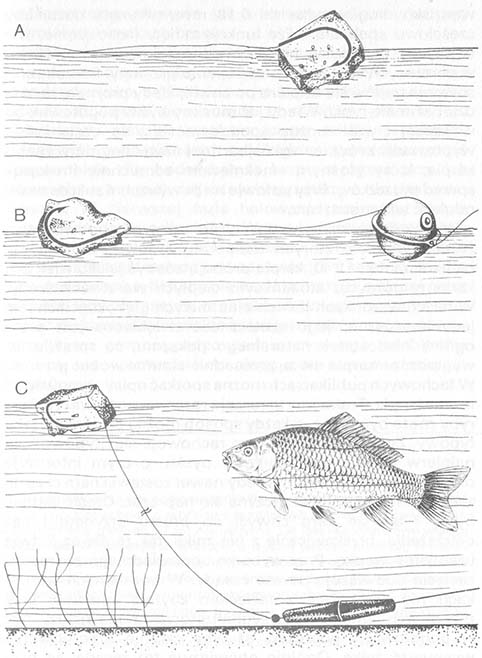 Zasadnicze sposoby połowu karpia na powierzchni: na niewielkie odległości można łowić nie obciążonym zestawem (A) lub też za pomocą kuli wodnej (B), na większe odległości można posłużyć się ciężarkiem przelotowym (C), przy czym przypon musi mieć długość większą niż głębokość wody, by przynęta wypłynęła na powierzchnię.
Zasadnicze sposoby połowu karpia na powierzchni: na niewielkie odległości można łowić nie obciążonym zestawem (A) lub też za pomocą kuli wodnej (B), na większe odległości można posłużyć się ciężarkiem przelotowym (C), przy czym przypon musi mieć długość większą niż głębokość wody, by przynęta wypłynęła na powierzchnię.
Połów karpi przebywających tuż pod powierzchnią podczas parnych letnich dni wymaga nie byle jakiego mistrza, który potrafi umieścić przynętę (kawałek skórki chlebowej, świeżego rogalika itp.) w dużej odległości w ten sposób, by jak najdłużej utrzymywała się na powierzchni. Każde obciążenie wymagałoby zrównoważenia spławikiem, lepiej więc zdecydować się na nieco większy kawałek skórki, który (aby był cięższy) namoczymy przed zarzuceniem w wodzie. Podczas rzutu skórka nieco przeschnie i utrzyma się na powierzchni. Długość rzutów można zwiększyć przez ustawienie się z wiatrem. Zestaw do połowu na powierzchni musi być delikatny, wędzisko długie, żyłka do 0,18 mm, przynęta duża, aby częściowo spełniała także funkcję zanęty i obciążenia. Nie dajmy się zrazić pasywnością, brakiem zainteresowania karpi w pierwszych chwilach po zarzuceniu przynęty. Ich zainteresowanie pojawi się dopiero po chwili, kiedy przynętę zaczną dziobać małe rybki. Wtedy już musimy być w pogotowiu, bo w każdej chwili można spodziewać się, że uczta rybek wyprowadzi z równowagi najbardziej nawet flegmatycznego karpia, który głośnym cmoknięciem zdmuchnie im kąsek sprzed pyszczków. Przy połowie na powierzchni sukces może odnieść także muszkarz.
